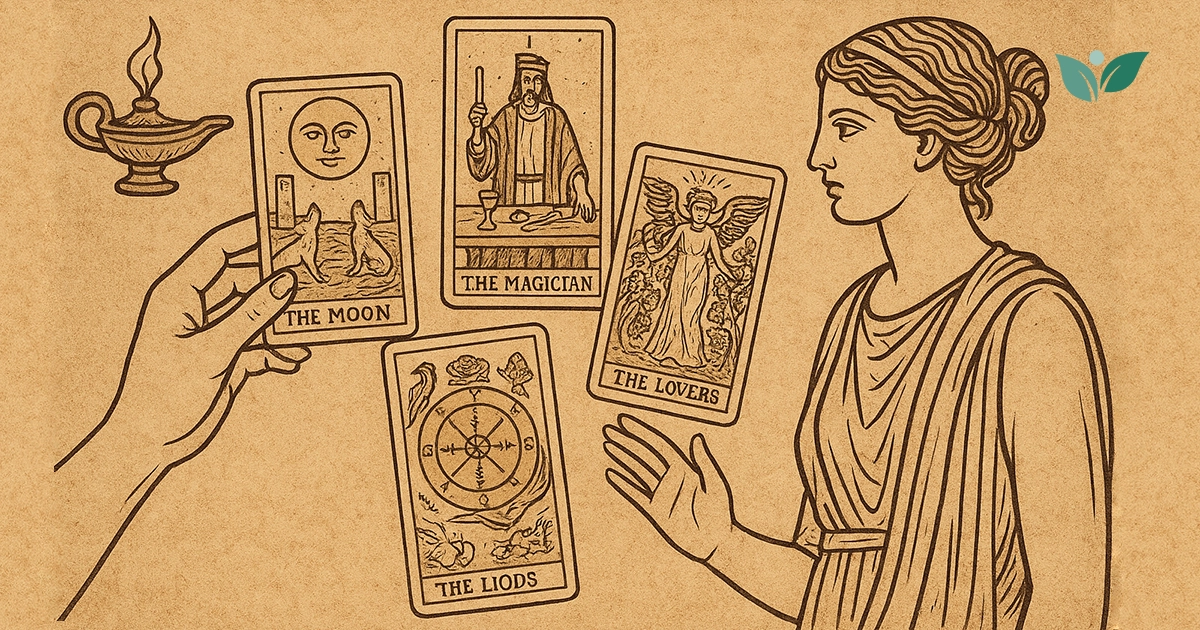Tarot cards are more than just beautifully illustrated images—they are symbolic guides that reflect life’s lessons, emotions, and experiences. Each card in a tarot deck has a unique meaning, offering insight into the challenges, opportunities, and energies surrounding a situation.
Whether you’re a complete beginner or a practicing reader, understanding the meanings of tarot cards is the foundation of accurate and intuitive readings. While guidebooks can help, learning the symbolism and context of each card will deepen your ability to connect with the tarot on a personal level.
This guide explores the Major Arcana and Minor Arcana, breaking down each card’s upright and reversed meanings. By the end, you’ll have a complete reference to use in your tarot journey.
Table of Contents
- What Are Tarot Cards?
- Structure of a Tarot Deck
- How to Read Tarot Card Meanings
- Major Arcana Cards (0–21) and Their Meanings
- Minor Arcana Cards and Their Meanings
- Suit of Wands
- Suit of Cups
- Suit of Swords
- Suit of Pentacles
- Upright vs. Reversed Tarot Meanings
- Common Symbols in Tarot Imagery
- How to Memorize Tarot Meanings
- Using Tarot Cards in Spreads
- FAQs
- Conclusion
What Are Tarot Cards?
Tarot cards are a set of 78 illustrated cards used for self-reflection, guidance, and divination. Each card carries symbolic meaning drawn from archetypes, mythology, numerology, and psychology.
Far from being just a “fortune-telling” tool, tarot is a way to explore patterns, gain clarity, and reflect on life choices.
Structure of a Tarot Deck
A standard tarot deck has:
- 22 Major Arcana cards – Life lessons and spiritual archetypes.
- 56 Minor Arcana cards – Everyday situations and experiences, divided into four suits: Wands, Cups, Swords, and Pentacles.
How to Read Tarot Card Meanings
Each card has:
- Upright meaning – Its main energy.
- Reversed meaning – Blocked, opposite, or shadow expression.
- Symbolism – Visual clues that add depth.
- Context – Meanings shift depending on the question and spread.
Major Arcana Cards (0–21) and Their Meanings
0. The Fool
- Upright: New beginnings, innocence, adventure.
- Reversed: Recklessness, hesitation, poor planning.
I. The Magician
- Upright: Manifestation, resourcefulness, power.
- Reversed: Manipulation, deception, wasted talent.
II. The High Priestess
- Upright: Intuition, hidden knowledge, mystery.
- Reversed: Secrets, blocked intuition, confusion.
… (Continue through all 22 cards: The Empress, Emperor, Lovers, Chariot, Strength, Hermit, Wheel of Fortune, Justice, Hanged Man, Death, Temperance, Devil, Tower, Star, Moon, Sun, Judgment, World)
Minor Arcana Cards and Their Meanings
Suit of Wands (Fire – Creativity, Action)
- Ace of Wands: Inspiration, new opportunities. (Reversed: Lack of motivation)
- Two of Wands: Planning, future vision. (Reversed: Fear of change)
- (Continue through all 14 cards up to King of Wands)
Suit of Cups (Water – Emotions, Relationships)
- Ace of Cups: New love, emotional awakening. (Reversed: Blocked emotions)
- Two of Cups: Partnership, harmony. (Reversed: Breakup, imbalance)
- (Continue through all 14 cards)
Suit of Swords (Air – Intellect, Conflict)
- Ace of Swords: Clarity, truth, breakthroughs. (Reversed: Confusion, dishonesty)
- Three of Swords: Heartbreak, grief. (Reversed: Healing, release)
- (Continue through all 14 cards)
Suit of Pentacles (Earth – Work, Finances, Material Life)
- Ace of Pentacles: Prosperity, new career opportunity. (Reversed: Missed chance)
- Ten of Pentacles: Wealth, family legacy. (Reversed: Financial loss, instability)
- (Continue through all 14 cards)
Upright vs. Reversed Tarot Meanings
- Upright: Represents the primary energy of the card.
- Reversed: Not always “negative”—can mean delays, blockages, or internalized energy.
Common Symbols in Tarot Imagery
- The Sun: Clarity, joy, truth.
- Water: Emotions, intuition.
- Mountains: Challenges, growth.
- Animals: Instincts, guidance.
How to Memorize Tarot Meanings
- Study one card a day.
- Use tarot journaling.
- Create flashcards.
- Focus on symbols, not just words.
Using Tarot Cards in Spreads
- One-card daily pull – Learn meanings in context.
- Three-card spread – Past, present, future.
- Celtic Cross – Comprehensive analysis.
FAQs
- Do tarot cards always mean the same thing? No, meanings shift depending on the question and spread.
- Should beginners memorize all 78 cards at once? No—start with the Major Arcana, then move to the suits.
- Do reversed cards have to be used? Not necessarily. Beginners can ignore reversals at first.
Conclusion
Tarot cards are more than symbols—they are guides to deeper self-understanding. By learning the meanings of each card, you unlock a language of intuition that helps you reflect, heal, and grow.
The key is practice. Start with daily pulls, keep a tarot journal, and slowly expand your knowledge of the 78 cards. Over time, you’ll notice that the cards don’t just “tell you something”—they start to speak with you.
👉 Your tarot journey begins with the first card. Pick one today and let it guide you.


